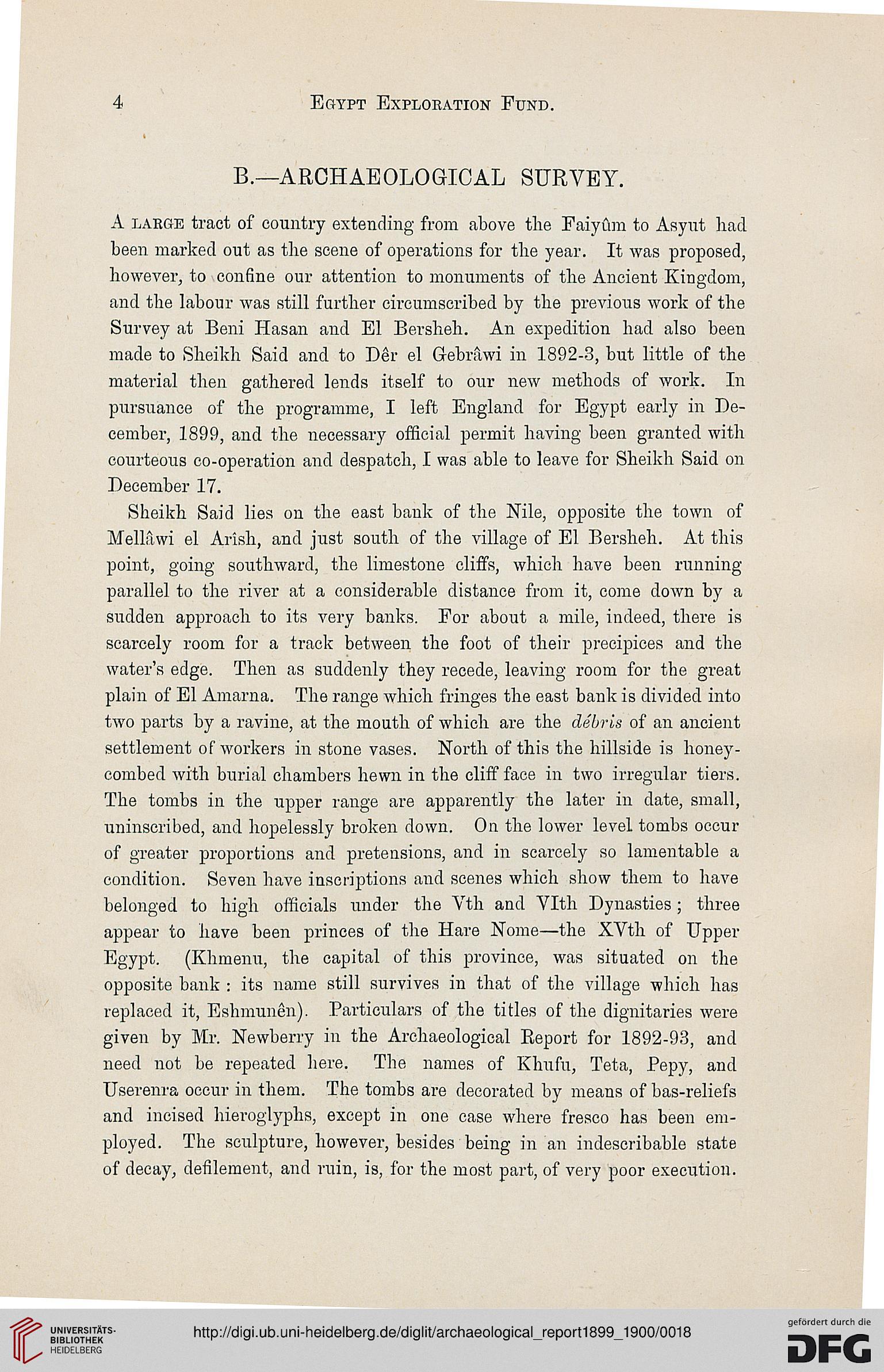4
Egypt Exploration Fund.
B.—ARCHAEOLOGICAL SURVEY.
A large tract of country extending from above the Faiyiim to Asyut had
been marked out as the scene of operations for the year. It was proposed,
however, to confine our attention to monuments of the Ancient Kingdom,
and the labour was still further circumscribed by the previous work of the
Survey at Beni Hasan and El Bersheh. An expedition had also been
made to Sheikh Said and to Der el Grebrawi in 1892-3, but little of the
material then gathered lends itself to our new methods of work. In
pursuance of the programme, I left England for Egypt early in De-
cember, 1899, and the necessary official permit having been granted with
courteous co-operation and despatch, I was able to leave for Sheikh Said on
December 17.
Sheikh Said lies on the east bank of the Nile, opposite the town of
Mellawi el Arish, and just south of the village of El Bersheh. At this
point, going southward, the limestone cliffs, which have been running-
parallel to the river at a considerable distance from it, come down by a
sudden approach to its very banks. For about a mile, indeed, there is
scarcely room for a track between the foot of their precipices and the
water's edge. Then as suddenly they recede, leaving room for the great
plain of El A mama. The range which fringes the east bank is divided into
two parts by a ravine, at the mouth of which are the debris of an ancient
settlement of workers in stone vases. North of this the hillside is honey-
combed with burial chambers hewn in the cliff face in two irregular tiers.
The tombs in the upper range are apparently the later in date, small,
uninscribed, and hopelessly broken down. On the lower level tombs occur
of greater proportions and pretensions, and in scarcely so lamentable a
condition. Seven have inscriptions and scenes which show them to have
belonged to high officials under the Vth and Vlth Dynasties; three
appear to have been princes of the Hare Nome—the XVth of Upper
Egypt. (Khmenu, the capital of this province, was situated on the
opposite bank : its name still survives in that of the village which has
replaced it, Eshmunen). Particulars of the titles of the dignitaries were
given by Mr. Newberry in the Archaeological Beport for 1892-93, and
need not be repeated here. The names of Khufu, Teta, Pepy, and
Userenra occur in them. The tombs are decorated by means of bas-reliefs
and incised hieroglyphs, except in one case where fresco has been em-
ployed. The sculpture, however, besides being in an indescribable state
of decay, defilement, and ruin, is, for the most part, of very poor execution.
Egypt Exploration Fund.
B.—ARCHAEOLOGICAL SURVEY.
A large tract of country extending from above the Faiyiim to Asyut had
been marked out as the scene of operations for the year. It was proposed,
however, to confine our attention to monuments of the Ancient Kingdom,
and the labour was still further circumscribed by the previous work of the
Survey at Beni Hasan and El Bersheh. An expedition had also been
made to Sheikh Said and to Der el Grebrawi in 1892-3, but little of the
material then gathered lends itself to our new methods of work. In
pursuance of the programme, I left England for Egypt early in De-
cember, 1899, and the necessary official permit having been granted with
courteous co-operation and despatch, I was able to leave for Sheikh Said on
December 17.
Sheikh Said lies on the east bank of the Nile, opposite the town of
Mellawi el Arish, and just south of the village of El Bersheh. At this
point, going southward, the limestone cliffs, which have been running-
parallel to the river at a considerable distance from it, come down by a
sudden approach to its very banks. For about a mile, indeed, there is
scarcely room for a track between the foot of their precipices and the
water's edge. Then as suddenly they recede, leaving room for the great
plain of El A mama. The range which fringes the east bank is divided into
two parts by a ravine, at the mouth of which are the debris of an ancient
settlement of workers in stone vases. North of this the hillside is honey-
combed with burial chambers hewn in the cliff face in two irregular tiers.
The tombs in the upper range are apparently the later in date, small,
uninscribed, and hopelessly broken down. On the lower level tombs occur
of greater proportions and pretensions, and in scarcely so lamentable a
condition. Seven have inscriptions and scenes which show them to have
belonged to high officials under the Vth and Vlth Dynasties; three
appear to have been princes of the Hare Nome—the XVth of Upper
Egypt. (Khmenu, the capital of this province, was situated on the
opposite bank : its name still survives in that of the village which has
replaced it, Eshmunen). Particulars of the titles of the dignitaries were
given by Mr. Newberry in the Archaeological Beport for 1892-93, and
need not be repeated here. The names of Khufu, Teta, Pepy, and
Userenra occur in them. The tombs are decorated by means of bas-reliefs
and incised hieroglyphs, except in one case where fresco has been em-
ployed. The sculpture, however, besides being in an indescribable state
of decay, defilement, and ruin, is, for the most part, of very poor execution.





